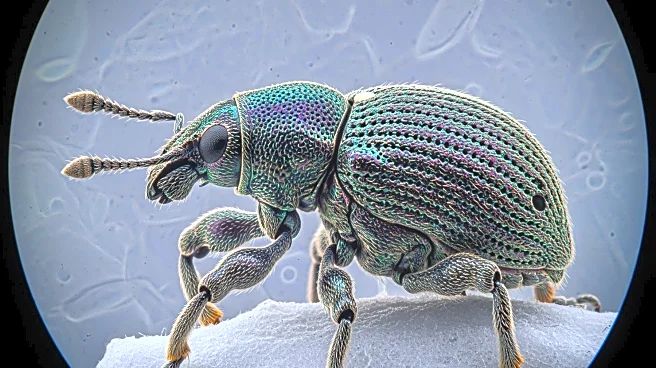What's Happening?
The 2025 Nikon Small World photomicrography contest has awarded its top prize to an image of a rice weevil on a grain of rice, captured by Zhang You from Yunnan, China. This annual contest, established
in 1974, aims to highlight the beauty and complexity of microscopic images. Photomicrography involves using a camera attached to a microscope to capture high-resolution images of small objects. Zhang You's winning image provides insight into the structure and behavior of rice weevils, a common agricultural pest. The image was noted for its artistic and scientific merit, showcasing the insect with its wings spread, a rare occurrence that was captured serendipitously.
Why It's Important?
The recognition of Zhang You's image underscores the importance of photomicrography in both scientific research and artistic expression. By providing detailed views of microscopic subjects, such images can enhance understanding of biological processes and contribute to scientific discoveries. The contest highlights the intersection of art and science, encouraging further exploration and innovation in imaging techniques. This can lead to advancements in fields such as entomology, where understanding insect behavior and structure is crucial for managing pests that impact agriculture. The contest also promotes public appreciation for the intricate beauty of the microscopic world.
What's Next?
The Nikon Small World contest continues to inspire scientists and artists to explore the microscopic world, potentially leading to new discoveries and innovations in imaging technology. As digital imaging methods advance, participants may produce even more detailed and striking images, further bridging the gap between science and art. The contest's ongoing popularity suggests a growing interest in photomicrography, which could lead to increased funding and research opportunities in related fields.
Beyond the Headlines
The contest not only celebrates scientific achievement but also raises ethical considerations regarding the portrayal of living organisms. As photomicrography becomes more popular, discussions about the ethical treatment of subjects and the impact of imaging on biodiversity may emerge. Additionally, the contest may influence cultural perceptions of insects and other microscopic organisms, fostering a greater appreciation for their roles in ecosystems.











